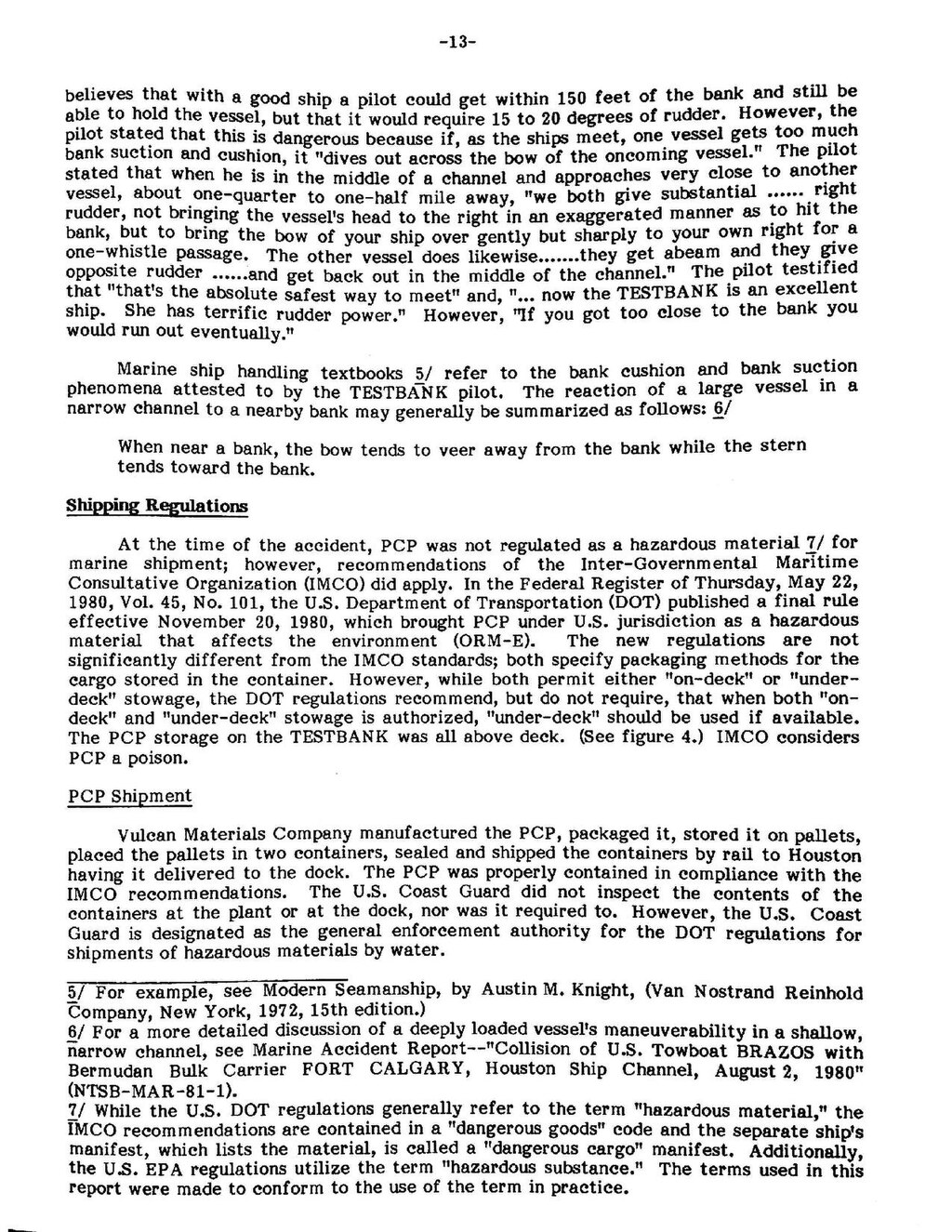believes that with a good ship a pilot could get within 150 feet of the bank and still be able to hold the vessel, but that it would require 15 to 20 degrees of rudder. However, the pilot stated that this is dangerous because if, as the ships meet, one vessel gets too much bank suction and cushion, it "dives out across the bow of the oncoming vessel." The pilot stated that when he is in the middle of a channel and approaches very close to another vessel, about one-quarter to one-half mile away, "we both give substantial…right rudder, not bringing the vessel's head to the right in an exaggerated manner as to his the bank, but to bring the bow of your ship over gently but sharply to your own right for a one-whistle passage. The other vessel does likewise…they get abeam and they give opposite rudder…and get back out in the middle of the channel." The pilot testified that "that's the absolute safest way to meet" and, "…now the Testbank is an excellent ship. She has terrific rudder power." However, "If you get too close to the bank you would run out eventually."
Marine ship handling textbooks[1] refer to the bank cushion and bank suction phenomena attested to by the Testbank pilot. The reaction of a large vessel in a narrow channel to a nearby bank may generally be summarized as follows:[2]
When near a bank, the bow tends to veer away from the bank while the stern tends toward the bank.
Shipping Regulations
At the time of the accident, PCP was not regulated as a hazardous material[3] for marine shipment; however, recommendations of the Inter-Governmental Maritime Consultative Organization (IMCO) did apply. In the Federal Register of Thursday, May 22, 1980, Vol. 45, No. 101, the U.S. Department of Transportation (DOT) published a final rule effective November 20, 1980, which brought PCP under U.S. jurisdiction as a hazardous material that affects the environment (ORM-E). The new regulations are not significantly different from the IMCO standards; both specify packaging methods for the cargo stored in the container. However, while both permit either "on-deck" or "under-deck" stowage, the DOT regulations recommend, but do not require, that when both "on-deck" and "under-deck" stowage is authorized, "under-deck" should be used if available. The PCP storage on the Testbank was all above deck. (See figure 4). IMCO considers PCP a poison.
PCP Shipment
Vulcan Materials Company manufactured the PCP, packaged it, stored it on pallets, placed the pallets in two containers, sealed and shipped the containers by rail to Houston having it delivered to the dock. The PCP was properly contained in compliance with the IMCO recommendations. The U.S. Coast Guard did not inspect the contents of the containers at the plant or at the dock, nor was it required to. However, the U.S. Coast Guard is designated as the general enforcement authority for the DOT regulations for shipments of hazardous materials by water.
- ↑ For example, see Modern Seamanship, by Austin M. Knight, (Van Nostrand Reinhold Company, New York, 1972, 15th edition.)
- ↑ For a more detailed discussion of a deeply loaded vessel's maneuverability in a shallow, narrow channel, see Marine Accident Report--"Collision of U.S. Towboat Brazos with Bermudan Bulk Carrier Fort Calgary, Houston Ship Channel, August 2, 1980" (NTSB-MAR-81-1).
- ↑ While the U.S. DOT regulations generally refer to the term "hazardous material," the IMCO recommendations are contained in a "dangerous goods" code and the separate ships manifest, which lists the material, is called a "dangerous cargo" manifest. Additionally, the U.S. EPA regulations utilize the term "hazardous substance." The terms used in this report were made to conform to the use of the term in practice.
